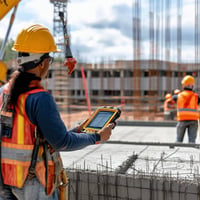When managing a construction project, understanding how your concrete is performing — and when it's...
Best Practices for Pouring Concrete in Hot Weather
When pouring concrete in hot weather, you’re racing against time. High temperatures can rapidly accelerate the hydration process, leading to poor strength development, cracking, and reduced long-term durability. Whether you're building a highway, bridge, or foundation, understanding how heat affects concrete — and how to monitor it — is critical for success.

How High Temperatures Impact Concrete
Concrete gains strength through hydration, a chemical reaction between cement and water. In normal conditions, this process is relatively controlled. But in hot weather – especially when the temperature to pour concrete exceeds safe limits – several challenges emerge:
- Rapid water evaporation: Causes plastic shrinkage cracks.
- Accelerated hydration: Results in lower long-term strength and higher permeability.
- Reduced workability: Shortens the time available for finishing.
- Thermal cracking: Develops when temperature gradients between surface and core are too significant.
These effects are not just cosmetic — they impact the safety, durability, and lifecycle cost of concrete structures.
Best Practices for Pouring Concrete in Hot Weather
Contractors and DOTs must take special precautions when working in elevated temperatures. Here are some tips to keep in mind when pouring in warm weather:
- Cool the mix: Use chilled water or ice in the mix to lower the initial temperature.
- Avoid midday pours: Schedule work during cooler parts of the day.
- Use admixtures: Set-retarding admixtures slow hydration and extend workability.
- Protect the pour: Use windbreaks, sunshades, or misting systems to reduce evaporation.
- Cure promptly: Begin curing as soon as possible to retain moisture and control temperature.
But even with these methods, there’s one critical factor that often goes overlooked: real-time temperature monitoring.
How Concrete Sensors Come Into Play During Warm Weather
Concrete temperature testing isn’t a luxury — it’s essential. That’s where concrete strength sensors come in.
With these sensors, you can continuously monitor the internal temperature of the pour and track real-time strength development. This provides engineers and contractors with a comprehensive view of how the concrete behaves, particularly during warm weather conditions.
For example, with our REBEL concrete sensors, you can:
- Identify overheating risks during curing
- Make informed decisions on the timing of formwork removal
- Improve quality control and reduce the risk of thermal cracking
- Ensure compliance with project specs and AASHTO standards
Maturity Sensor in Hot Weather
In hot weather, maturity sensors often overestimate concrete strength due to elevated curing temperatures, which can lead to premature formwork removal or early loading. This creates safety risks and potential structural issues. Concrete sensors, like REBEL, eliminate this guesswork by directly measuring concrete strength in real time, providing accurate data regardless of ambient heat.
Knowledge is Power — Especially in the Heat
Hot weather concrete placement doesn't have to be risky. With the proper planning, tools, and concrete temperature tests, your project can stay on track and perform as designed for decades.
Want to learn more about how REBEL sensors can protect your concrete in extreme temperatures? Contact us to schedule a demo or explore our case studies.
Contact Us for a Quote



